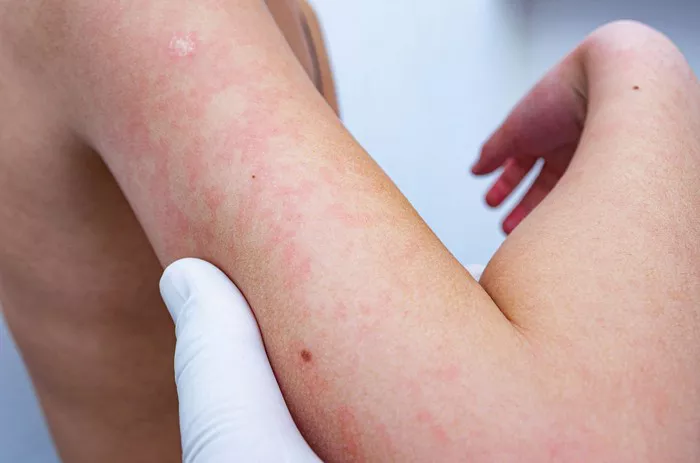Hives, also known as urticaria, are a common skin condition characterized by raised, red, and itchy welts on the skin. This condition can be triggered by various factors, including allergies, stress, medications, and underlying health conditions. While hives typically resolve on their own within a few days or weeks, they can cause significant discomfort and distress. Fortunately, numerous topical treatments are available to help alleviate symptoms and promote healing. In this article, we will explore some of the most effective topical treatments for hives, their mechanisms of action, and how they can provide relief for individuals experiencing this bothersome condition.
Understanding Hives: Causes and Symptoms
Before delving into the specifics of topical treatments, it is essential to understand the underlying causes and symptoms of hives. Hives occur when certain cells in the skin release histamine and other chemicals in response to allergens or other triggers. This release of chemicals leads to inflammation, which manifests as the characteristic red, raised welts associated with hives.
Common triggers for hives include:
1. Allergens: Certain foods, medications, insect stings, pollen, pet dander, and other allergens can trigger an immune response, resulting in hives.
2. Environmental Factors: Extreme temperatures, sunlight exposure, and pressure on the skin (such as from tight clothing) can also trigger hives in some individuals.
3. Stress: Emotional stress and anxiety can exacerbate hives or even be a primary trigger for some individuals.
4. Underlying Health Conditions: Hives can be a symptom of underlying health conditions, such as autoimmune disorders, infections, or thyroid problems.
The symptoms of hives typically include:
Raised, red welts on the skin
Itching, which may be mild to severe
Swelling of the affected area
Burning or stinging sensation
Now that we have a better understanding of hives and their symptoms, let’s explore some of the most effective topical treatments for managing this condition.
Topical Treatments for Hives
1. Antihistamine Creams and Lotions:
Antihistamine creams and lotions are commonly used to relieve itching and reduce inflammation associated with hives. These topical formulations contain ingredients such as diphenhydramine, hydroxyzine, or cetirizine, which block the effects of histamine, thereby reducing itchiness and discomfort. When applied directly to the affected area, antihistamine creams provide rapid relief from hives symptoms.
2. Calamine Lotion:
Calamine lotion is another popular topical treatment for hives due to its soothing and anti-inflammatory properties. It contains a combination of zinc oxide and ferric oxide, which help to relieve itching and reduce redness associated with hives. Calamine lotion can be applied liberally to the affected area as needed for relief.
3. Corticosteroid Creams:
Corticosteroid creams are effective at reducing inflammation and itching associated with hives. These topical medications contain corticosteroids such as hydrocortisone, which help to suppress the immune response and alleviate symptoms. Corticosteroid creams should be used sparingly and as directed by a healthcare professional to avoid potential side effects such as thinning of the skin.
4. Oatmeal Baths:
Oatmeal baths can provide relief for individuals experiencing widespread hives or itching. Oatmeal has anti-inflammatory properties and forms a protective barrier over the skin, helping to soothe irritation and reduce itching. To use, simply add colloidal oatmeal to a warm bath and soak for 15-20 minutes. Pat the skin dry afterward to avoid further irritation.
5. Cool Compresses:
Cool compresses can help alleviate itching and swelling associated with hives. Simply soak a clean cloth in cold water, wring out excess moisture, and apply it to the affected area for 10-15 minutes. The cool temperature helps to constrict blood vessels and reduce inflammation, providing temporary relief from hives symptoms.
6. Aloe Vera Gel:
Aloe vera gel is well-known for its soothing and anti-inflammatory properties, making it a popular topical treatment for hives. Applying a thin layer of aloe vera gel to the affected area can help reduce itching, redness, and swelling associated with hives. Look for pure aloe vera gel or products containing a high concentration of aloe vera extract for best results.
7. Topical Anesthetics:
Topical anesthetics such as lidocaine or pramoxine can provide temporary relief from itching and discomfort associated with hives. These medications work by numbing the nerve endings in the skin, reducing the sensation of itching and providing fast-acting relief. However, they should be used sparingly and as directed to avoid potential side effects.
Conclusion
Hives can be a frustrating and uncomfortable skin condition, but effective topical treatments are available to help alleviate symptoms and promote healing. Whether you prefer antihistamine creams, corticosteroid preparations, or natural remedies such as oatmeal baths and aloe vera gel, there are numerous options to choose from based on your preferences and needs. However, it is essential to consult with a healthcare professional before starting any new treatment regimen, especially if you have underlying health conditions or are taking medications that may interact with topical treatments. With the right approach, you can find relief from hives and restore comfort to your skin.






















